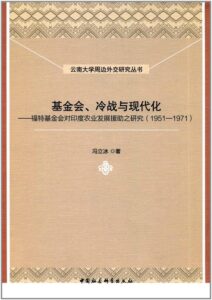
Feng Libing 冯立冰
China Social Sciences Press, Beijing, 2016
Reviewed by: Mao Keji (PhD Candidate, Tsinghua University, HYI Visiting Fellow)
Dr. Feng’s work thoroughly surveys the Ford Foundation’s assistance programs for India’s agriculture, the consequences these programs produced, and the evaluations of these consequences. While this book is a specific, historical, and empirical case study, it critiques the theories of international aid, development economics, and agricultural economics, paying special attention to the concepts and ideologies behind India’s quest for catch-up modernization and its geostrategic maneuvers during the Cold War.
The author mainly utilized and explored three sets of historical materials: 1) Douglas Ensminger’s oral history. Douglas Ensminger was the Ford Foundation’s representative in India from 1951 to 1971 and had a valuable first-hand account of what was going on. 2) The archives documents including the Ford Foundation’s funding applications from India, grant documents, research reports on Indian projects, and important correspondence documents. 3) The US diplomatic documents and congressional records.
There are at least three impressive points worth highlighting in the book:
1) The book examines the special role that the Ford Foundation played in the context of the US general aid policy to India. First, Dr. Feng talks about how the Ford Foundation guided India’s agricultural development policy by funding social science research, which was far more flexible and effective than the official guidance from the U.S. embassy. Secondly, the Foundation funded natural science research and then applied it in India. In the 1960s, the Foundation promoted high-yield wheat and rice seeds to India, and after 1966, they were used on a large scale in India’s official new agricultural strategy. Thirdly the Foundation organized experts to evaluate India’s food production and agricultural situation, making recommendations.
2) The book reflects on the repercussions and limitations of the Foundation’s aid program to India. For example, the Foundation’s development design made India increasingly rely on foreign inputs like fertilizers, seeds, and machinery, which would consume huge amounts of foreign exchange. India, to obtain foreign loans and further assistance, was then forced to make concessions to international players. For another example, the Foundation’s development concepts overlooked social structure transformation in rural India. Without social reform or revolution, higher agricultural output only led to polarization in productivity and wealth in villages. Ideas like rural community development hinged on a few landed castes and elites in the village. In this way, the introduction of modern farming technology, high-yield seeds, and fertilizers in effect helped to widen the existing economic and social inequalities.
3) it comprehensively reviews the three different agricultural development strategies that the Indian government implemented successively between 1951 and 1971. For example, it summarizes and compares these ideas to the major theories of agricultural development held by the US, the Ford Foundation, the Nehruvian elites, the Gandhian followers, and the Soviet Union. Moreover, with a reference to a timeline, the book also traces how some of these ideas evolved and single out the years of critical points. So, with agricultural development theories as well as their changes along the timeline visualized in the tabular format, readers can easily make horizontal comparisons among different ideas, or vertical comparisons among different stages of the same idea.
